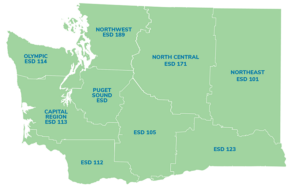Welcome Service Providers

Washington (OSPI)
OSPI is the primary agency charged with overseeing public K–12 education in Washington state. Working with the state's 295 public school districts and 6 state-tribal education compact schools, OSPI allocates funding and provides tools, resources, and technical assistance so every student in Washington is provided a high-quality public education.
Vision: All students prepared for post-secondary pathways, careers, and civic engagement.
Gen:Thrive
Project Overview Here
The Washington Office of Superintendent of Public Instruction (OSPI) Environmental and Sustainability Education program and E3 Washington, the state affiliate of the North American Association of Environmental Education (NAAEE) are collaborating to build a map of Environmental and Sustainability Education (ESE) providers and associated resources. The map, dashboard, analysis tools, and other features are intended for use by:
- PK-12 educators/schools/districts to find ESE resources in their region,
- Community-based organizations, government agencies, and other partners to support service and collaboration,
-
Formal and nonformal PK-12 and pre-service educators to access professional learning/higher education opportunities, and
-
OSPI and others to conduct resource analysis and identify solutions that will best support students historically underserved by science education.
Expected Outcomes
- This map will increase access to and engagement with ESE organizations statewide. It will boost access for educators and community based organizations to find and work with each other. The map will help educators find local organizations engaging in environmental science research, sustainability education, engineering solutions, providing natural resource career pathways in their communities, and more.
- Spatial analysis provides an additional depth and breadth of analysis when compared to traditional resource databases. For example, environmental and socioeconomic data will support educator and student understanding of local environmental problems, perspectives, solutions, and challenges of sustainability.
- The map may be used to customize environmental and sustainability education resources so they best fit the communities we serve.
Is your organization in our directory?
Search our directory to find your organization.
Find your organization? Your Partner Organization should have sent you an Invitation Code. Click the red "Register" button to begin the registration process. If you do not have any invitation code, contact us to receive your code.
 Please select the district(s) your located in. Used this map for reference.
Please select the district(s) your located in. Used this map for reference.